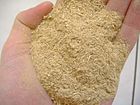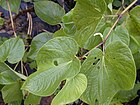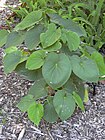Note: This is a project under development. The articles on this wiki are just being initiated and broadly incomplete. You can Help creating new pages.
Difference between revisions of "Piper methysticum - Kava"
(Created page with "thumb|right|''Kava'' '''Kava''' or '''kava-kava''' is a crop of the western Pacific. The roots of the plant are used to produ...") |
|||
| (16 intermediate revisions by 3 users not shown) | |||
| Line 1: | Line 1: | ||
[[File:Starr 070515-7054 Piper methysticum.jpg|thumb|right|''Kava'']] | [[File:Starr 070515-7054 Piper methysticum.jpg|thumb|right|''Kava'']] | ||
| + | '''Kava''' is a crop of the western Pacific. Kava is consumed throughout the Pacific Ocean cultures of Polynesia, including Hawaii, Vanuatu, Melanesia and some parts of Micronesia for its sedating effects. | ||
| + | ==Uses== | ||
| + | {{Uses|Nausea}}, {{Uses|Loss of appetite}}, {{Uses|Tiredness}}, {{Uses|Liver disorders}}, {{Uses|Abdominal pain}}, {{Uses|Dark urine}}, {{Uses|Anxiety }},{{Uses|Stress}}, {{Uses|Sore throats}} | ||
| − | + | ==Parts Used== | |
| + | {{Parts Used|Roots}}, {{Parts Used|Rhizome}}. | ||
| − | == | + | ==Chemical Composition== |
| − | + | Trimethyl-1-naphthol, 5-methyl-1-phenylhexen-3-yn-5-ol, octadecadienoic acid-methyl ester, Dimethylflavanone, Pinostrobin chalcone and 7-dimethoxyflavanone-5 hydroxy<ref name="chemical composition"/> | |
| − | |||
| − | + | ==Common names== | |
| + | {{Common names|kn=|ml=|sa=|ta=|te=|hi=|en=Ava, Ava Pepper}} | ||
| − | + | ==Properties== | |
| + | Reference: Dravya - Substance, Rasa - Taste, Guna - Qualities, Veerya - Potency, Vipaka - Post-digesion effect, Karma - Pharmacological activity, Prabhava - Therepeutics. | ||
| + | ===Dravya=== | ||
| − | == | + | ===Rasa=== |
| + | Tikta (Bitter), Kashaya (Astringent) | ||
| + | ===Guna=== | ||
| + | Laghu (Light), Ruksha (Dry), Tikshna (Sharp) | ||
| + | ===Veerya=== | ||
| + | Ushna (Hot) | ||
| + | ===Vipaka=== | ||
| + | Katu (Pungent) | ||
| + | ===Karma=== | ||
| + | Kapha, Vata | ||
| + | ===Prabhava=== | ||
| − | + | ==Habit== | |
| + | {{Habit|Shrub}} | ||
| − | == References == | + | ==Identification== |
| − | + | ===Leaf=== | |
| − | <references> | + | {{Leaf|Simple|Alternate|The leaves are heart-shaped, 10-30 cm x 8-23 cm; stipules large, persistent}}<ref name="Leaf"/> |
| − | <ref name=" | + | |
| + | ===Flower=== | ||
| + | {{Flower|Unisexual|3-9 cm long|Yellow|2|The female spike bears flowers with a single basal ovule in an unilocular ovary topped by a stigma.}} | ||
| + | |||
| + | ===Fruit=== | ||
| + | {{Fruit|General|7–10 mm|Fruit seldom produced; a berry containing one seed||single}} | ||
| + | |||
| + | ===Other features=== | ||
| + | |||
| + | ==List of Ayurvedic medicine in which the herb is used== | ||
| + | |||
| + | ==Where to get the saplings== | ||
| + | ==Mode of Propagation== | ||
| + | {{Propagation|Seeds}}, {{Propagation|Cuttings}}. | ||
| + | |||
| + | ==How to plant/cultivate== | ||
| + | The kava plant is propagated from cuttings taken from the lower stems or from the younger stems once separated from the rootstock when the root is harvested.<ref name="How to plant/cultivate"/> | ||
| + | |||
| + | ==Commonly seen growing in areas== | ||
| + | {{Commonly seen|Damp areas}}, {{Commonly seen|Near streams}}, {{Commonly seen|Borders of forests}}. | ||
| + | |||
| + | ==Photo Gallery== | ||
| + | <gallery class="left" caption="" widths="140px" heights="140px"> | ||
| + | Starr 021122-0033 Piper methysticum.jpg | ||
| + | Starr 021122-0034 Piper methysticum.jpg | ||
| + | File:Starr-091104-8928-Piper methysticum-leaves and flower spikes-Kahanu Gardens NTBG Kaeleku Hana-Maui (24962022846).jpg|Flowers | ||
| + | File:Kava-powder-from-vanuatu-ready-to-mix-with-water.jpg | ||
| + | Starr 021122-0035 Piper methysticum.jpg | ||
| + | Starr 021122-0036 Piper methysticum.jpg | ||
| + | Starr 040318-0058 Piper methysticum.jpg | ||
| + | Starr 050407-6214 Piper methysticum.jpg | ||
| + | Starr 050407-6215 Piper methysticum.jpg | ||
| + | </gallery> | ||
| + | |||
| + | ==References== | ||
| + | |||
| + | <references> | ||
| + | <ref name="chemical composition">[https://www.ncbi.nlm.nih.gov/pubmed/18404321 Chemical components]</ref> | ||
| + | |||
| + | <ref name="Leaf">[http://www.worldagroforestry.org/treedb/AFTPDFS/Piper_methysticum.PDF BOTANIC DESCRIPTION]</ref> | ||
| + | |||
| + | <ref name="How to plant/cultivate">[https://kava.com/articles/botany-of-kava/ Cultivation]</ref> | ||
</references> | </references> | ||
| − | == External Links == | + | ==External Links== |
| − | + | * [https://www.sciencedirect.com/topics/agricultural-and-biological-sciences/piper-methysticum Piper methysticum on science direct] | |
| − | *[https:// | + | * [https://www.encyclopedia.com/medicine/drugs/pharmacology/kava-plant Piper methysticum on encyclopedea.com] |
| + | * [https://www.konakavafarm.com/piper_methysticum.html Piper methysticum on konakavafarm.com] | ||
| + | * [http://www.takimai.com/grow-kava-harvest/ Piper methysticum on grow kava harvest in takimai] | ||
[[Category:Herbs]] | [[Category:Herbs]] | ||
| + | [[Category:Piperaceae]] | ||
Latest revision as of 17:11, 2 July 2020
Kava is a crop of the western Pacific. Kava is consumed throughout the Pacific Ocean cultures of Polynesia, including Hawaii, Vanuatu, Melanesia and some parts of Micronesia for its sedating effects.
Contents
- 1 Uses
- 2 Parts Used
- 3 Chemical Composition
- 4 Common names
- 5 Properties
- 6 Habit
- 7 Identification
- 8 List of Ayurvedic medicine in which the herb is used
- 9 Where to get the saplings
- 10 Mode of Propagation
- 11 How to plant/cultivate
- 12 Commonly seen growing in areas
- 13 Photo Gallery
- 14 References
- 15 External Links
Uses
Nausea, Loss of appetite, Tiredness, Liver disorders, Abdominal pain, Dark urine, Anxiety ,Stress, Sore throats
Parts Used
Chemical Composition
Trimethyl-1-naphthol, 5-methyl-1-phenylhexen-3-yn-5-ol, octadecadienoic acid-methyl ester, Dimethylflavanone, Pinostrobin chalcone and 7-dimethoxyflavanone-5 hydroxy[1]
Common names
| Language | Common name |
|---|---|
| Kannada | |
| Hindi | |
| Malayalam | |
| Tamil | |
| Telugu | |
| Marathi | NA |
| Gujarathi | NA |
| Punjabi | NA |
| Kashmiri | NA |
| Sanskrit | |
| English | Ava, Ava Pepper |
Properties
Reference: Dravya - Substance, Rasa - Taste, Guna - Qualities, Veerya - Potency, Vipaka - Post-digesion effect, Karma - Pharmacological activity, Prabhava - Therepeutics.
Dravya
Rasa
Tikta (Bitter), Kashaya (Astringent)
Guna
Laghu (Light), Ruksha (Dry), Tikshna (Sharp)
Veerya
Ushna (Hot)
Vipaka
Katu (Pungent)
Karma
Kapha, Vata
Prabhava
Habit
Identification
Leaf
| Kind | Shape | Feature |
|---|---|---|
| Simple | Alternate | The leaves are heart-shaped, 10-30 cm x 8-23 cm; stipules large, persistent |
Flower
| Type | Size | Color and composition | Stamen | More information |
|---|---|---|---|---|
| Unisexual | 3-9 cm long | Yellow | 2 | The female spike bears flowers with a single basal ovule in an unilocular ovary topped by a stigma. |
Fruit
| Type | Size | Mass | Appearance | Seeds | More information |
|---|---|---|---|---|---|
| General | 7–10 mm | Fruit seldom produced; a berry containing one seed | single | {{{6}}} |
Other features
List of Ayurvedic medicine in which the herb is used
Where to get the saplings
Mode of Propagation
How to plant/cultivate
The kava plant is propagated from cuttings taken from the lower stems or from the younger stems once separated from the rootstock when the root is harvested.[3]
Commonly seen growing in areas
Damp areas, Near streams, Borders of forests.
Photo Gallery
References
External Links
- Ayurvedic Herbs known to be helpful to treat Nausea
- Ayurvedic Herbs known to be helpful to treat Loss of appetite
- Ayurvedic Herbs known to be helpful to treat Tiredness
- Ayurvedic Herbs known to be helpful to treat Liver disorders
- Ayurvedic Herbs known to be helpful to treat Abdominal pain
- Ayurvedic Herbs known to be helpful to treat Dark urine
- Ayurvedic Herbs known to be helpful to treat Anxiety
- Ayurvedic Herbs known to be helpful to treat Stress
- Ayurvedic Herbs known to be helpful to treat Sore throats
- Herbs with Roots used in medicine
- Herbs with Rhizome used in medicine
- Herbs with common name in English
- Habit - Shrub
- Index of Plants which can be propagated by Seeds
- Index of Plants which can be propagated by Cuttings
- Herbs that are commonly seen in the region of Damp areas
- Herbs that are commonly seen in the region of Near streams
- Herbs that are commonly seen in the region of Borders of forests
- Herbs
- Piperaceae









